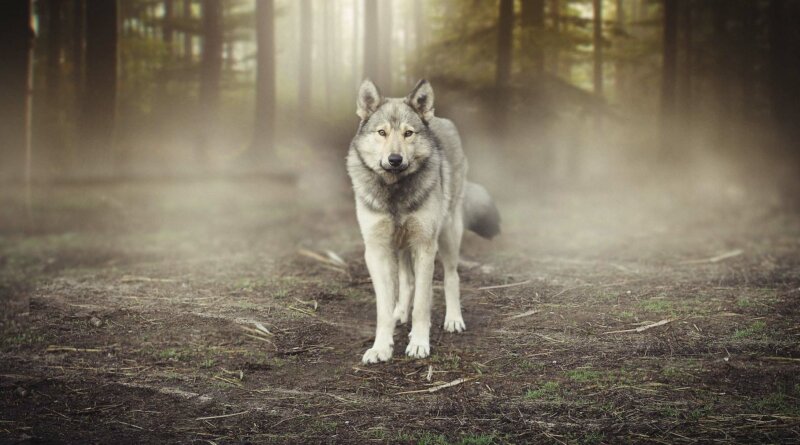From Wolf Pack to Human Pack
Wolves are icons of pack behavior. Their collective strength is greater than their individual efforts. As Rudyard Kipling put it, “for the strength of the Pack is the Wolf, and the strength of the Wolf is the Pack.” Wolves play a large role in the history of dogs, and learning about wolf behavior can shed a lot of light on the natural instincts of our canine companions.
Wolves engage in an intimate pact of survival: from finding food and keeping each other safe to warding off rival legions of wolves and other predators, their cooperative skills are legendary. Obviously, domesticated dogs are no longer a part of such packs (1).
Dogs are a part of a new “pack;” if you will, the “human pack.”
The human pack, at first glance, is a mostly domestic affair as far as the dog is concerned. There is certainly less romance in living a comfortable life with favorable circumstances, but this is not the whole story of the history of dogs. It cannot be so easily brushed aside as a caricature of decadence.
So what of this transition, then? What of the brave and loyal canine who has gone from the wolf pack to the human pack? Is he the same, or has he become something else entirely?
What we know about past and present wolves offers a point of departure in which we can place the current relationship dogs have with humans and learn a lot about the history of dogs.
Because wolves still exist in very similar form to when they evolved into modern dogs (2), we are able to very precisely see what has changed and what has stayed the same throughout the history of dogs.
The Social Hierarchy of Wolf Packs
In terms of wolf socialstructure, modern researchers suggest that a wolf pack is best viewed as an extended family, instead of the often popularized view of a rigid hierarchy with an “alpha male” (3; 4).
Rather than all wolves gunning for the top spot, it is believed that social harmony in wolf packs is prioritized for the sake of overall stability (5; 6; 7).
Much like human families begin, researcher L. David Mech noticed that wolf packs are usually started by two young wolves that come from other different packs and are strangers to one another, much like how human relationships are started (8; 9).
It’s then standard for young wolves leave the pack between 1 and 3 years of age to undertake their own “family business” (10; 11).
The wolf hierarchy is less linear and more pyramidal. In other words, there is a gradation of social status in which males and parents are more dominant, where wolves switch from one role to another as they get older (12).
North American wolves historically have preyed upon game such as caribou, moose, and reindeer. During the warm months they will also rely more extensively on smaller animals like rabbits and even squirrels (13; 14).
When Dogs Joined the “Human Pack”
Dogs, being the very first of many domesticated species, have been incorporated more extensively and effectively than any other animal (15). For many families they are considered nothing less than part of the family.
Part of this process, animal researchers believe, led to dog’s developing more “infantile” like behaviors. They have also developed greater responsiveness to social reinforcers (what we know today as petting, praise and human attention), which made them more desirable as companions (16; 17).
Dogs became much more attuned to us. In fact, there’s an argument to be made that we may have not domesticated dogs but instead they domesticated us, as friendly wolves sought companionship (18).
Regardless, like any working relationship, the affection must go both ways if it is to have any staying power. Indeed, dogs have been shown to impact us greatly and more studies are coming out proving the two-way benefits of canine-human bond.
For example, since 1980s to this day dogs have been observed in studies to exhibit a tremendous beneficial influence on the social and emotional development of young children (19).
For three decades, the presence of dogs have been observed in controlled studies to have a calming effect on both children and adults, lowering blood pressure in contexts such as during college exams or during a doctor’s exam (20; 21; 22).
General stress relief in many other contexts is arguably the greatest benefit for humans that dogs offer. Therapy dogs provide stress relief at work, and taking your dog for a walk has been shown to lead to greater relaxation (higher parasympathetic nervous system activity) and lower stress levels among other psychosocial and psychophysiological benefits (23; 24; 25).
Wolves and human social structures are similar in many ways. Both often prioritize social harmony. As wolves transitioned to dogs and developed a relationship to humans, certain changes in behavior occurred (both in dogs as well as in humans). To account for companionship, each side needed to gain important benefits.
There is no such thing as biological “free lunch,” however.
If you look closely, several of the above studies have also observed in various domains that for every advantage gained in one area, there is a consequential loss in another. That is to say, specialization of skill is often a trade off – and this can be seen in the history of dogs.
While most research has looked at the benefits dogs give to us, for decades substantially less emphasis has been given to the effect that we have on our dogs (26).
Thus the question remains for us, and our scientists, to answer: what impact have we made on our canine companions as they’ve joined our ranks, or what we can now call the “human pack”? What did the transition from being wolves (Canis lupus) in wolf packs to dogs (Canis familiaris) in human packs resulted in, and what our now beloved pets gained from this?
To understand this fully, we need to look at and dig deeper into the differences between wild wolves and domesticated dogs.
The Differences Between Wolves and Dogs
Many differences have been noted on the contrast physically between dogs and wolves (27). Dogs, obviously, are much more varied and different looking than their wolf predecessors because of the domestication process and selective breeding techniques throughout centuries.
Dogs are also typically smaller in size of body and skull than wolves are (28; 29). Wolves ears are always erect and never droopy, unlike most dogs, and there’s a good reason why (30).
Getting beyond skin deep, dogs have been shown to have smaller brains relative to their wild counterparts (31). This may be due to the identity of their most immediate ancestor, which, compared to other wolves, had a relatively smaller brain to begin with.
Wolves do show better problem solving skills than dogs, however (32), and they understand cause and effect much better than canines (33). But dogs show better training ability than wolves do. This bargain of sorts is thought to have occurred for one of two reasons.
First, the effects of domestication in the history of dogs led to a trade off between tractability (the ability for a dog to be trained) and cognitive abilities (34). It’s like the idea that in order to learn something you have to be able to suspend what you do know. Dogs may do this better, perhaps (depending on how you look at it) to their detriment in certain situations.
The second reason is that dogs have inherited an ability to behave and be more socially dependent (35). In other words, there is less of the ‘me’ involved for dogs, and more of the ‘us.’
So, the first theory basically says dogs aren’t as smart as wolves and this was part of their evolutionary trade-off. The second says dogs use their intelligence in a more collaborative way with their owner, working as a team, rather than taking action all by themselves, something that wolves are actually bad at (36).
Studies found that it depends on the relationship between the owner and the dog (37). That is, whether it was a “companion relationship,” as in a dog who lives in a family, or a “working relationship,” such as a dog that helps in a police department. The canine-human bond covers several areas for the dog, and your pet understands it (38).
Depending on the type of attachment, dogs will behave more or less codependently, unlike wolves or cats (39; 40). Not surprisingly, in problem solving situations dogs that were considered ‘part of the family’ behaved in a more socially dependent manner.
With greater social bonding to a family, the more likely it was for the dog to behave in a co-dependent fashion. In a sense, the more dogs are incorporated into a human family, the more dogs appear to have an inclination toward mutual cooperation with their owners (41).
Several researchers conclude that it is likely that dogs have a tendency to interact with humans as a “social unit.” Instead of dogs being less able problem solvers, rather, they prefer to work as a team, or pack. If you contrast this behavior to other domestic animals, such as cats, it is interesting to note how much dogs’ relationship with humans stands in contrast.
While cat behavior cannot be described as strictly asocial, they are certainly less social than dogs (42). I think we are all familiar with the stereotypical ‘aloof’ cat. Felines, in the strict sense of the word, have only been domesticated for the past 200 years, and as any modern cat owner would’ve expect, DNA shows they have done it themselves (43). Their relationship with humans is consummate to this length of time, perhaps.
Certainly, cats do not tend to relegate their autonomy in the way dogs do. However, given the vast difference between these two animals and the fact that they don’t generally serve the same kinds of purposes or relationships for humans, it is difficult to compare them directly. The point being that cats, in contrast with dogs, do not typically function within a social unit as dogs are capable.
To give this discussion greater perspective, in the 1950’s foxes were domesticated by the Russian geneticist Belyaev to “reenact” the domestication process that happened in the history of dogs (44). Interestingly, the general conclusion over this period of time, however, is that although being similar to dogs in many ways, foxes do not yet compare with dogs in terms of social behavior (45).
While more time is certainly needed to play out the tens of thousands of years in which dogs were domesticated, the preliminary results go against the notion that all animals can be domesticated as successfully as the history of dogs shows in terms of integrating into social structures. Serendipity is a big factor, yet each animal brings a subset of hardwired behaviors that are difficult if not impossible to alter.
Social Attachment of Dogs and Humans
Among domesticated animals, dogs are considered unique in their social attachment to humans. This is not a huge surprise among dog owners, but within the spectrum of domesticated animals it is rather remarkable. When it comes to the history of dogs, humans play a large role (46).
Dogs like us so much (you could say), it is even thought that they, to a certain extent, may have domesticated themselves just like cats did. An influential theory about how wolves became domesticated notes that based on following and picking up human leftovers, wolves began to become attached to humans – an alternate hypothesis better known as self-domestication.
The more social or “outgoing” wolves were, the more likely they were to engage in this behavior (47). Dogs that were more shy were less likely to follow humans around and generally stayed away.
It is possible that the more social wolves would have wandered toward the cooperative relationship that they now have with humans. Perhaps certain humans that utilized dogs outperformed groups that didn’t.
In fact, it is thought that the dog-human alliance may have contributed to humans (Homo Sapiens) beating out neanderthal (Homo Neanderthalensis) competitors, as well as reaching the current dominance in the foodchain that we still both enjoy, according to some historical evidence (48).
Two apex predators learned to cooperate for their mutual benefit: a unique and highly effective symbiosis.
Who Domesticated Who?
You could argue that dogs have gotten the greatest benefit from the present arrangement. No need to hunt. No need to worry about predators trying to eat them. No need to surmount the bitter cold, and raise disobedient children.
One interpretation of this is that dogs “reverse-domesticated” us, in retrospect. But it’s mostly a matter of perspective. Studies which suggest dogs aren’t as intelligent as their wolf counterparts may be correct, even know it’s not something canine community would like to hear. The truth is, dogs don’t have to think as hard about solving their problems anymore, especially when compared to modern wolves.
Just as humans invented computers to do work for us, maybe dogs found us an advantage in freeing themselves and increasing their chances of survival. After all, although humans created them, we aren’t as smart as our computers anymore.
Dogs are the first animal to be domesticated by humans, and this large part of the history of dogs led to a relationship without equal in terms of two predators working together. Dogs may or may not have lost some of their cognitive abilities and accentuated their social skills in the transition from being wolves to becoming dogs and human companions.
What About Free Roaming Dogs?
Despite the clearcut differences which can be seen between wolf packs and human-dog packs, there are free ranging dogs, too. Surprisingly, free roaming dogs are estimated to makeup anywhere from 76% to 83% of the global population of dogs (49).
What can free range dogs tell us about the history of domesticated dogs from wolf pack to human pack? It turns out that free roaming dogs are capable of and do form packs that are similar to wolf packs, including using cooperative behaviors such as finding food together and cooperation in defense of territory.
However, there are important differences which have been observed, most likely resulting from their adaptation to a domestic environment and living among humans (50). For example, dogs living in urban environments have been seen acting in more isolated ways, like scavenging by themselves (though lone wolves are not an altogether uncommon occurrence either).
Greater “individuality” is thought to occur because food is found in smaller amounts throughout the urban environment, in various areas throughout a city (51). In contrast, when there are large amounts of food available in one area, like a garbage dump, dogs have been seen to exhibit more pack-like behavior (52).
Indeed, wolves too have been found to extensively utilize garbage dumps as sources of food in certain environments, such as in studies that observed Italian and Israeli wolves (53; 54). Like their wolf brethren, in certain environments feral dogs have also been found to hunt larger wild and domestic animals, such as sheep and young cows (55). In certain places like Australia, it’s a real problem, too (56).
Studies observed how wolf packs tend to control larger amounts of land area than dog packs do (57). Also, unlike wolves, dogs do not use howls to coordinate their movements, but rather tend to bark to intimidate rival packs away from food sources (58). In addition, dogs are thought to have different greeting patterns in terms of barking, because they have lost certain glands (e.g., the supracaudal gland) that assist in their olfactory signalling.
Overall, there are a few general statements that can be made regarding the physical differentiation of wolves from dogs, whether in terms of bone structure, such as the length of the humerus, or minor skull differences (59).
Some dogs are very different from wolves indeed. However, certain wolf-like dog breeds and those that can be compared one to one with wolves (like the Irish Wolfhound, for example) reveal that there is a lot of overlap between dog and wolf traits, at least among modern wolf species. As the history of dogs observed, both species – wolves and dogs – have been impacted as a result of domestication (whether our or self-domestication) and cross-breeding of canines.
In Conclusion
Overall, the history of dogs shows many similarities between dog packs and wolf packs, but dogs have adapted their behavior more closely to the human world (59). Even among free ranging dogs, this more closely resembles scavenging from humans. However, this is not all that different from wolves, which rely extensively on carrion (and garbage in some cases) as a food source in the wild.
Despite the differences, dogs and wolves still share many similarities.
Not unlike Little Red Riding Hood, the history of dogs shows that our furry companions are quite a bit like wolves dressed in human clothing. They are, however, much better at restraining themselves and, moreover, have developed significantly better social skills and “manners” to remain our closest friends.
It is amazing that virtually every human culture some 40,000 years ago independently took in dogs to their society (60). Indeed, evidence from burial sites indicates that humans then had a special, even spiritual connection with their canine companions. We still continue to find evidence such as what Mayas used to do with their canine companions about 2,500 years ago (61).
The relationship humans and dogs have today is as strong as ever. As Aristotle said, “without friends no one would choose to live.” Dogs would probably smile and agree, adding, “choosing survival, means having friends.”
READ NEXT: Dog Domestication History (In Years)









Read information now. Read information now.
how can i get generic avodart
Generic Name. Generic Name.
deep web drug markets tor markets
[url=https://xenical.pics/]buy xenical online cheap australia[/url]